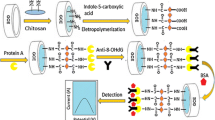Abstract
We describe the electrochemical determination of oxidative damaged DNA by using a nanocarbon film electrode combined with a high performance liquid chromatography (HPLC) system. The nanocarbon film was formed by employing the electron cyclotron resonance sputtering method, and has a nano-crystalline sp2 and sp3 mixed bond structure with an atomically flat surface. This film electrode provided the high electrode activity and stability needed to quantitatively detect oxidative damaged DNA, 8-hydroxy-2'-deoxyguanosine (8-OHdG), by direct electrochemical oxidation. The coefficient of variation (C.V.) value of 1 µM 8-OHdG at our film electrode was 0.75% (n = 12), which constitutes superior reproducibility to that of a conventional glassy carbon (GC) electrode (9.28%, n = 12) in flow-injection analysis. This was because the nanocarbon film suppressed fouling for the oxidized product of 8-OHdG owing to its hydrophilically ultraflat and chemically stable surface. We also investigated the performance of HPLC with an electrochemical detection (HPLC-ECD) system using our nanocarbon film electrode. The detection limit for 8-OHdG at the nanocarbon film electrode was 3 nM, which was superior to the detection limit of the GC electrode (7.2 nM). Furthermore, this electrode was more suitable for use in a urinary 8-OHdG experiment than the GC electrode. The concentration of urinary 8-OHdG in the urinary sample was 8.30 nM. These results indicate that this HPLC-ECD system with our nanocarbon film electrode enables us to realize an accurate, sensitive, reproducible and easy to use analysis technique.
Similar content being viewed by others
References
H. Kasai, H. Hayami, Z. Yamaizumi, H. Saito, and S. Nishimura, Nucleic Acids Res., 1984, 12, 2127.
M. C. Peoples and H. T. Karnes, J. Chromatogr., B, 2005, 827, 5.
M. S. Cooke, R. Olinski, S. Loft, and Escula, Cancer Epidem. Biomar., 2008, 17, 3.
M. S. Cooke, R. Olinski, S. Loft, and M. D. Evans, Free Radical Res., 2008, 42, S102.
A. Valavanidis, T. Vlachogianni, and C. Fiotakis, J. Environ. Sci. Health, Part C, 2009, 27, 120.
M. S. Cooke, M. D. Evans, R. Dove, R. Rozalski, D. Gackowski, A. Siomek, J. Lunec, and R. Olinski, Mutat. Res., Fundam. Mol. Mech. Mutagen., 2005, 574, 58.
D. Germadnik, A. Pilger, and H. W. Rudiger, J. Chromatogr., B, 1997, 689, 399.
M. L. Hamilton, Z. M. Guo, C. D. Fuller, H. Van Remmen, W. F. Ward, S. N. Austad, D. A. Troyer, I. Thompson, and A. Richardson, Nucleic Acids Res., 2001, 29, 2117.
B. S. de Martinis and M. D. L. P. Bianchi, Pharmacol. Res., 2002, 46, 129.
C. Y. Chen, L. Y. Qu, B. Li, L. Xing, G. Jia, T. C. Wang, Y. X. Gao, P. Q. Zhang, M. Li, W. Chen, and Z. F. Chai, Clin. Chem., 2005, 51, 759.
A. Pilger, S. Ivancsits, D. Germadnik, and H. W. Rudiger, J. Chromatogr., B, 2002, 778, 393.
M. Nakano, Y. Kawanishi, S. Kamohara, Y. Uchida, M. Shiota, Y. Inatomi, T. Komori, K. Miyazawa, K. Gondo, and I. Yamasawa, Free Radical Biol. Med., 2003, 35, 826.
S. Koide, Y. Kinoshita, N. Ito, J. Kimura, K. Yokoyama, and I. Karube, J. Chromatogr., B, 2010, 878, 2163.
A. Siomek, A. Rytarowska, A. Szaflarska-Poplawska, D. Gackowski, R. Rozalski, T. Dziaman, M. Czerwionka-Szaflarska, and R. Olinski, Carcinogenesis, 2006, 27, 405.
A. Weimann, D. Belling, and H. E. Poulsen, Free Radical Biol. Med., 2001, 30, 757.
A. Weimann, D. Belling, and H. E. Poulsen, Nucleic Acids Res., 2002, 30.
M. Harri, H. Kasai, T. Mori, J. Tornaeus, K. Savela, and K. Peltonen, J. Chromatogr., B, 2007, 853, 242.
S. Toyokuni, T. Tanaka, Y. Hatton, Y. Nishiyama, A. Yoshida, K. Uchida, H. Hiai, H. Ochi, and T. Osawa, Lab. Invest., 1997, 76, 365.
S. Toyokuni, Pathol. Int., 1999, 49, 91.
K. Shimoi, H. Kasai, N. Yokota, S. Toyokuni, and N. Kinae, Cancer Epidem. Biomar., 2002, 11, 767.
C. Bolin and F. Cardozo-Pelaez, J. Chromatogr., B, 2007, 856, 121.
S. Hirono, S. Umemura, M. Tomita, and R. Kaneko, Appl. Phys. Lett., 2002, 80, 425.
O. Niwa, J. Jia, Y. Sato, D. Kato, R. Kurita, K. Maruyama, K. Suzuki, and S. Hirono, J. Am. Chem. Soc., 2006, 128, 7144.
J. B. Jia, D. Kato, R. Kurita, Y. Sato, K. Maruyama, K. Suzuki, S. Hirono, T. Ando, and O. Niwa, Anal. Chem., 2007, 79, 98.
N. Sekioka, D. Kato, R. Kurita, S. Hirono, and O. Niwa, Sens. Actuators, B, 2008, 129, 442.
D. Kato, N. Sekioka, A. Ueda, R. Kurita, S. Hirono, K. Suzuki, and O. Niwa, J. Am. Chem. Soc., 2008, 130, 3716.
D. Kato, N. Sekioka, A. Ueda, R. Kurita, S. Hirono, K. Suzuki, and O. Niwa, Angew. Chem., Int. Ed., 2008, 47, 6681.
K. Goto, D. Kato, N. Sekioka, A. Ueda, S. Hirono, and O. Niwa, Anal. Biochem., 2010, 405, 59.
N. Sekioka, D. Kato, A. Ueda, T. Kamata, R. Kurita, S. Umemura, S. Hirono, and O. Niwa, Carbon, 2008, 46, 1918.
H. Inokuchi, D. Kato, A. Ueda, and O. Niwa, Electroanalysis, 2011, 23, 827.
T. A. Ivandini, K. Honda, T. N. Rao, A. Fujishima, and Y. Einaga, Talanta, 2007, 71, 648.
Author information
Authors and Affiliations
Corresponding author
Rights and permissions
About this article
Cite this article
Kato, D., Komoriya, M., Nakamoto, K. et al. Electrochemical Determination of Oxidative Damaged DNA with High Sensitivity and Stability Using a Nanocarbon Film. ANAL. SCI. 27, 703–707 (2011). https://doi.org/10.2116/analsci.27.703
Received:
Accepted:
Published:
Issue Date:
DOI: https://doi.org/10.2116/analsci.27.703




